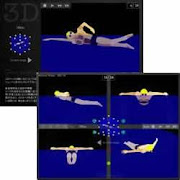 We applauded the courage of Mike Spalding and his fast-acting support crew when he was attacked by a cookiecutter shark 11 miles into his Alenuihaha Channel crossing.
We applauded the courage of Mike Spalding and his fast-acting support crew when he was attacked by a cookiecutter shark 11 miles into his Alenuihaha Channel crossing. Several readers have asked about the cookiecutter shark (Isistius brasiliensis), previously known as Cigar Sharks (see photo of alien-looking creature). Susan Scott of the Honolulu Star-Bulletin wrote an educational article on this unusual shark:
Several readers have asked about the cookiecutter shark (Isistius brasiliensis), previously known as Cigar Sharks (see photo of alien-looking creature). Susan Scott of the Honolulu Star-Bulletin wrote an educational article on this unusual shark:When a suspected cookiecutter shark bit Maui long-distance swimmer Mike Spalding on the leg last week, it was the first evidence of that species attacking a living person.
That surprised me because these little sharks bite just about everything that swims. Tunas, mahimahi, billfish, dolphins, monk seals, dugongs, humpback whales, sharks, rays and others occasionally bear the scars of cookiecutter shark bites. One even took a bite out of a rubber part on a submarine.
In all these cases it's a pretty sure bet who did the biting because the cookiecutter shark leaves a signature as distinct as the Z of Zorro. The bite is the size and shape of an Oreo cookie.
 Cookiecutters are tiny for sharks, growing only 20 inches long. They swim in tropical waters around the world but almost never connect with people because they spend their days in the deep ocean, sometimes more than two miles down. They come to the surface to feed, but only at night.
Cookiecutters are tiny for sharks, growing only 20 inches long. They swim in tropical waters around the world but almost never connect with people because they spend their days in the deep ocean, sometimes more than two miles down. They come to the surface to feed, but only at night.Mike was 11 miles offshore, at night, when he was bitten.
The cookiecutter is well suited to cut round chunks of flesh from its prey. The shark has protruding jaws and big suctorial lips, a term biologists use to mean they suck. When a prey gets close, the shark strikes by digging its needlelike upper teeth into the skin. Hanging on with its suction-cup lips, the shark then rotates its body in a circle, using its lower saw-shaped teeth to cut out a plug of flesh.
No one knows how long this cutting takes, but if it takes a while the shark can breathe while the mouth bites. Two respiratory holes called spiracles lie behind the eyes, allowing water to flow into the head and over the gills, exiting through slits on each side. Such gill slits are unique to sharks and their kin, the skates and rays.
 To test the theory that cookiecutter sharks made the scars commonly seen on tunas, in 1971 a Hawaii biologist made his own cookie cutter from the jaws of a dead cookiecutter shark. The shape and size of his cuts were identical to the ones on the tunas.
To test the theory that cookiecutter sharks made the scars commonly seen on tunas, in 1971 a Hawaii biologist made his own cookie cutter from the jaws of a dead cookiecutter shark. The shape and size of his cuts were identical to the ones on the tunas.The question that remained, however, was how these small, tubular fish (once called cigar fish) with puny fins get so close to fast-swimming animals, most of which are formidable predators themselves.
They turn on the lights. Bioluminescent organs that make green light cover the underside of the cookiecutter shark. (The shark's scientific name, Isistius, comes from Isis, the Egyptian goddess of light.) The theory is that large predators see the light and swim to it for a snack. But when they get close, they become the snack. Since these bites don't usually kill, cookiecutter sharks are considered parasites.
The cookiecutter scars I've seen on marine animals were smaller than the 3-inch-diameter, 1-inch-deep wound on Spalding's leg. His cut might be bigger because humans are soft, our skin stretches and wounds gape. It's possible something else did the biting, but circumstantial evidence points strongly to a cookiecutter shark.
Mike's swim made the record books, but certainly not in the way he intended. This ocean man, however, isn't going to let a rascally little shark spoil his quest. When his leg heals, he told reporters, he's going to try again to swim the Alenuihaha Channel.
May this time the goddess Isis not be with him.
Upper two photos by the Maui News. Third photo from top is from the ReefQuest Center for Shark Research. Fourth photo from top is from the Australian Museum.
Copyright © 2009 by World Open Water Swimming Association




















No comments:
Post a Comment